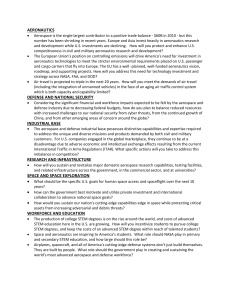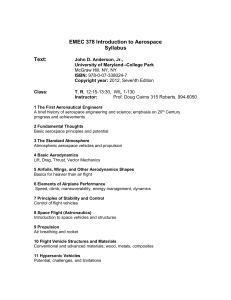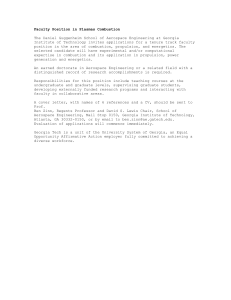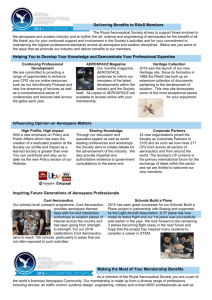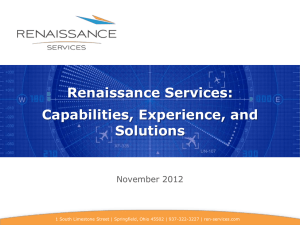Learn More - Division of Engineering and Applied Science
advertisement
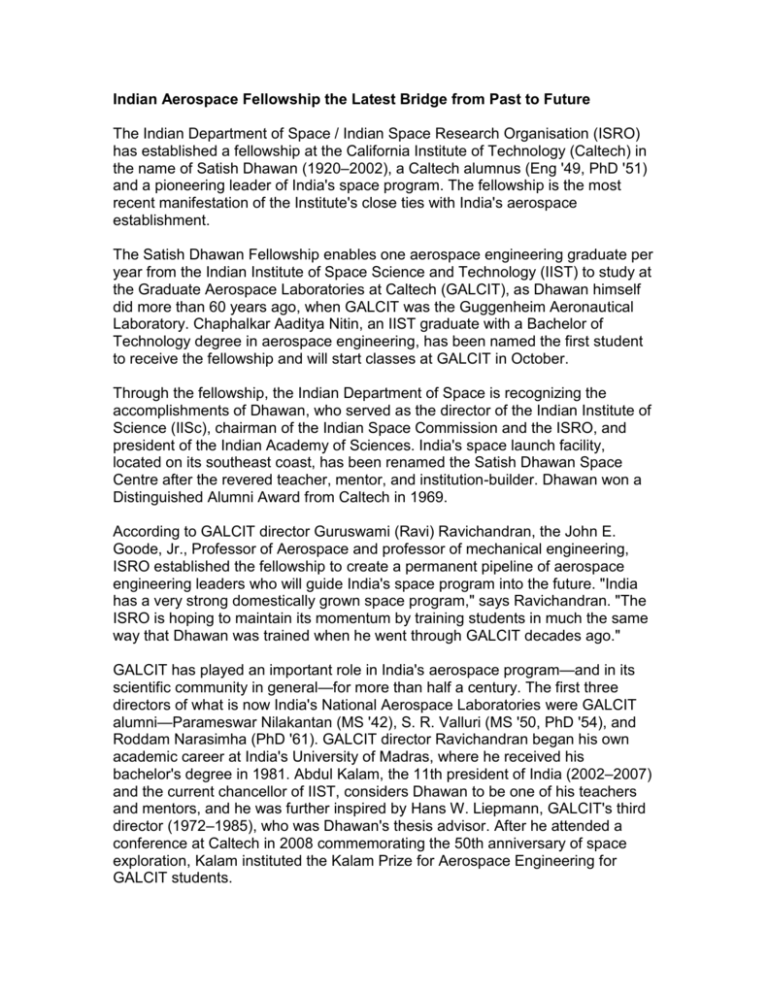
Indian Aerospace Fellowship the Latest Bridge from Past to Future The Indian Department of Space / Indian Space Research Organisation (ISRO) has established a fellowship at the California Institute of Technology (Caltech) in the name of Satish Dhawan (1920–2002), a Caltech alumnus (Eng '49, PhD '51) and a pioneering leader of India's space program. The fellowship is the most recent manifestation of the Institute's close ties with India's aerospace establishment. The Satish Dhawan Fellowship enables one aerospace engineering graduate per year from the Indian Institute of Space Science and Technology (IIST) to study at the Graduate Aerospace Laboratories at Caltech (GALCIT), as Dhawan himself did more than 60 years ago, when GALCIT was the Guggenheim Aeronautical Laboratory. Chaphalkar Aaditya Nitin, an IIST graduate with a Bachelor of Technology degree in aerospace engineering, has been named the first student to receive the fellowship and will start classes at GALCIT in October. Through the fellowship, the Indian Department of Space is recognizing the accomplishments of Dhawan, who served as the director of the Indian Institute of Science (IISc), chairman of the Indian Space Commission and the ISRO, and president of the Indian Academy of Sciences. India's space launch facility, located on its southeast coast, has been renamed the Satish Dhawan Space Centre after the revered teacher, mentor, and institution-builder. Dhawan won a Distinguished Alumni Award from Caltech in 1969. According to GALCIT director Guruswami (Ravi) Ravichandran, the John E. Goode, Jr., Professor of Aerospace and professor of mechanical engineering, ISRO established the fellowship to create a permanent pipeline of aerospace engineering leaders who will guide India's space program into the future. "India has a very strong domestically grown space program," says Ravichandran. "The ISRO is hoping to maintain its momentum by training students in much the same way that Dhawan was trained when he went through GALCIT decades ago." GALCIT has played an important role in India's aerospace program—and in its scientific community in general—for more than half a century. The first three directors of what is now India's National Aerospace Laboratories were GALCIT alumni—Parameswar Nilakantan (MS '42), S. R. Valluri (MS '50, PhD '54), and Roddam Narasimha (PhD '61). GALCIT director Ravichandran began his own academic career at India's University of Madras, where he received his bachelor's degree in 1981. Abdul Kalam, the 11th president of India (2002–2007) and the current chancellor of IIST, considers Dhawan to be one of his teachers and mentors, and he was further inspired by Hans W. Liepmann, GALCIT's third director (1972–1985), who was Dhawan's thesis advisor. After he attended a conference at Caltech in 2008 commemorating the 50th anniversary of space exploration, Kalam instituted the Kalam Prize for Aerospace Engineering for GALCIT students. "The ISRO is honoring Dhawan and Caltech with this fellowship, and it is also recognizing the historical connections between engineers and scientists in the United States and India," says Ares Rosakis, Caltech's Theodore von Kármán Professor of Aeronautics and Mechanical Engineering and Otis Booth Leadership Chair, Division of Engineering and Applied Science. "It is an endorsement of GALCIT's fundamental research approach and rigorous curriculum. "Most academic fellowships come from private philanthropy. It is extremely rare for a government institution to endow a fellowship intended for a private research institution such as Caltech," he says. Construction on the Guggenheim Laboratory at Caltech started in 1926 with a grant of $300,000 from the Daniel Guggenheim Fund for the Promotion of Aeronautics. The Guggenheim fund set up aeronautics programs at several leading universities around the United States, with Caltech serving as the Southern California hub. Eminent aeronautical scientist and engineer Theodore von Kármán was recruited to serve as GALCIT's first director. He later was the founding director of the Jet Propulsion Laboratory (JPL) and recipient of the first National Medal of Science from President John F. Kennedy in 1963. Built around a 10-foot wind tunnel, the Guggenheim Laboratory became an incubator for Southern California's nascent aircraft manufacturing industry. The first commercial airplane, the six-passenger Northrop Alpha, was tested in the GALCIT wind tunnel, as was every new commercial and military plane designed between 1935 and 1945. GALCIT trained many of the scientists and engineers who would become the industry's leaders in the second half of the 20th century. Over the decades, some of the most advanced aircraft in the world took shape at GALCIT, where basic research into structures, propulsion, and fluid and solid dynamics informed the design of supersonic aircraft. When GALCIT students started experimenting with rockets in 1936, von Kármán chose to move their rocket tests to a more remote (and safer) site in the Arroyo Seco, a few miles northwest of the Caltech campus; soon thereafter, JPL was born. Dhawan came to GALCIT after earning degrees at the University of Punjab in Lahore (at that time part of British India but later part of Pakistan), and the University of Minnesota. At GALCIT, he attended classes taught by Hsue-Shen Tsien, who was one of the founders of JPL along with von Kármán and Frank Malina. Tsien is considered the father of China's space program. In the obituary he wrote after Dhawan's death in 2002, Liepmann reflected on Dhawan's knack for making the most of the modest experimental equipment available at GALCIT at the time. Roddam Narasimha, a student of Dhawan's at the IISc in the 1950s, commented on his teacher's habit of carrying out research at the lowest possible cost "with ingenious development or adaptation of whatever materials, skills, and instrumentation were available at the time." The orientation toward experimentation—and the seemingly endless hours in the workshop—that reigned at GALCIT in its early days has carried over to the present, Ravichandran says. In the many labs and in the machine shop located in GALCIT, "students get their hands dirty," he says. "This gives students some physical reality to guide them, which also leads to innovation. It is one of the strong points of our program." "GALCIT typically takes a nonsystems approach," adds Ravichandran. "By focusing on the fundamentals of engineering sciences—the mechanics of fluids and solids, propulsion, structures, and so on—we are able to innovate in fields related to aerospace and beyond, and have a real impact on the world." For example, through studies of the hydrodynamics of schooling fish, research supported by the Gordon and Betty Moore Foundation, GALCIT's John Dabiri, a professor of aeronautics and bioengineering and director of the Biological Propulsion Laboratory, has devised a more efficient way to harvest wind energy. Meanwhile, Mory Gharib, the Hans W. Liepmann Professor of Aeronautics and Bioinspired Engineering and a Caltech vice provost, has invented painless drugdelivery microneedle arrays based on the sticky feet of the gecko and, by examining how heart valves develop in embryonic zebrafish, has designed a better fluid pump, among other work. Despite its relatively small size (12 full-time faculty and about 10 PhD and 15 MS graduates per year) compared to other universities, GALCIT has had an outsized impact on aeronautics and aerospace development in the United States and abroad, according to Rosakis. "It has done so not by training engineers in large numbers but by training engineering leaders," Rosakis says. "We are not equipped to supply large numbers of engineers to industry, but we have trained CEOs of aerospace companies and the heads of departments at places like MIT, Georgia Tech, and the University of Illinois. If we were to create one von Kármán every half century, as well as a few aerospace CEOs, and a few Dhawans, we would be happy."
